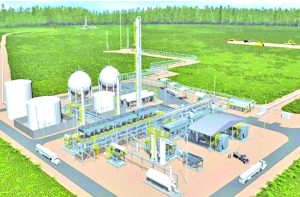This article was added by the user . TheWorldNews is not responsible for the content of the platform.
…says 300 MW of emergency power to be added to grid by year end
The fact that Guyana continues to experience regular power outages at the hands of the Guyana Power and Light (GPL), is a stark reminder of the challenges the former A Partnership for National Unity/Alliance For Change (APNU/AFC) left for the current Government.
This is according to Vice President Bharrat Jagdeo, in his presentation as he attended the commissioning of the $1 billion West Central Mall that was opened on Friday at Leonora, West Coast Demerara (WCD). He explained that while current demand for power is approximately 180 Megawatts, GPL only has 174 Megawatts of power installed.
 Vice President Bharrat Jagdeo
Vice President Bharrat Jagdeo According to Jagdeo, the People’s Progressive Party/Civic (PPP/C) Government is making a concerted effort to secure another 30 Megawatts of emergency power, hopefully before the end of the year. This will be an interim measure until the 300-Megawatt gas-to-energy project comes online.
“On electricity, you see a spate of blackouts now. We had always argued that the lack of investments in a timely manner affects you. Because there’s a laggy effect to the economic policy. It affects you down the road? So, when APNU killed the hydro and didn’t reinvest in new capacity and because the prices are lower. When fuel prices went up, the Government subsidised the price of electricity and water to keep the cost of living down. We’re subsidising it.”
“So, a lot of the big users, who were self-generating, they’ve come on the grid and taking power from GPL. So, our demand now, in a single night, is 180 Megawatts. And we only have 174 Megawatts of installed capacity. So, you have of necessity, to take some people off the grid. We just agreed on a policy that we’ll put a punitive tax for those big users who come onto the grid, because it’s at the peak period where demand is greater than the supply,” Jagdeo said.
According to the Vice President, Guyana is suffering the economic consequences of the APNU/AFC’s “shortsightedness”. He noted that while people get upset at the power outages, the reality is that the former coalition Government made no investments in power generation between 2015 and 2020. Jagdeo further recalled the measures the PPP/C Government took when they entered Government, for instance reversing Value Added Tax (VAT) on electricity.


“We promised a series of measures in our manifesto, when we contested the 2020 elections. We said, if we win these elections, here are the things we will implement. First, remove the disincentive of higher taxes. So, we reverse almost all those taxes. We reverse VAT on a whole range of electricity, water, services.”
“If you were operating this facility a few years back under APNU, you would have had to pay now a 14 per cent tax on your electricity use and water use and data, that you don’t have to pay today. So annualised, all those taxes we removed resulted in people paying, over the period of a year, $40 billion less taxes than they were paying under the Opposition.”
Jagdeo noted that once the gas-to-energy project comes online, electricity prices will come down by 50 per cent. This will result in some of the lowest electricity prices in the Region, as well as the cooking gas needed.
It was only Friday that GPL announced it had recorded its highest-ever electricity generation and demand in the Demerara-Berbice Interconnected System (DBIS), leading the utility company to encourage consumers to practice electricity conservation.
The company recorded a peak demand of 182 Megawatts (MW) compared to 154 MW for the corresponding period last year.
This notable increase in electricity generation and consumption can be attributed to the increasingly high temperatures over the past few months and growth in the housing and commercial sectors, the utility company deduced.
The Government is aiming for a massive energy mix to ensure stable electricity output with the multibillion-dollar transformational gas-to-energy project which includes the construction of an integrated Natural Gas Liquid (NGL) plant and a 300-megawatt (MW) combined cycle power plant at Wales, West Bank Demerara (WBD).
By 2025, with 300 MW of new baseload capacity provided with natural gas, the reliability of the Demerara-Berbice Interconnected System (DBIS) grid will increase while the Green House Gas (GHG) emissions associated with electricity generation will be reduced by half. (G3)






